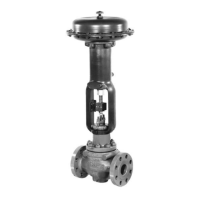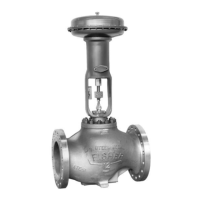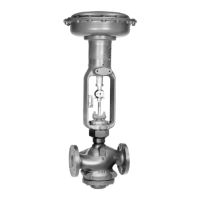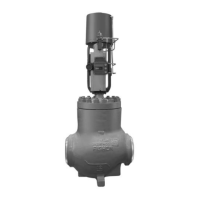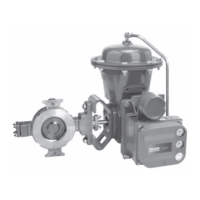Instruction Manual
D102010X012
EU and EW Series Valves
July 2017
13
For EUD, EWD, EUT, and EWT valves (figure 6), unscrew the seat ring cap screws (key 49). Install screws or bolts into
the tapped holes in the top of the seat ring (key 9) and carefully lift it out of the valve body. Remove the gasket
(key 13).
7. Inspect parts for wear or damage that would prevent proper operation of the valve. Replace or repair trim parts
according to the following Lapping Seating Surfaces or Valve Plug Maintenance procedures as appropriate.
Lapping Seating Surfaces
A certain amount of leakage should be expected with metal‐to‐metal seating in any valve body. If the leakage
becomes excessive, however, the condition of the seating surfaces of the valve plug and seat ring can be improved by
lapping. (Deep nicks should be machined out rather than ground out.) Use a good quality lapping compound of a
mixture of 280 to 600‐grit. Apply the compound to the bottom of the valve plug.
Assemble the valve to the extent that the cage or cage assembly is in place and the bonnet is bolted to the valve body.
A simple handle can be made from a piece of strap iron locked to the valve plug stem with nuts. Rotate the handle
alternately in each direction to lap the seats. After lapping, remove the bonnet, and clean the seat surfaces.
Completely assemble the valve as described in the Trim Replacement section, and test the valve for shutoff. Repeat
the lapping procedure if leakage is still excessive.
Valve Plug Maintenance
Except where indicated, key numbers in this section are shown in figure 5 for EUT‐2 and EWT‐2 valves and in figure 6
for EUD and EWD valves.
CAUTION
For valves with a PTFE seal ring (figure 5, 6, or 7), if replacing the valve plug seal ring (key 28), be careful not to scratch the
surfaces of the ring groove in the valve plug or any of the surfaces of the replacement ring, or the replacement ring may not
seal properly.
1. Remove the valve plug (key 2) according to the Disassembly section.
2. For seal‐ring constructions, carefully pry or cut the seal ring (key 28, figure 5, 6, or 7) from its groove in the plug.
Install the replacement spring‐loaded seal ring with the open side facing the top or bottom of the valve plug,
depending on flow direction. The open side of the seal ring should face up (toward the actuator) in flow‐up
installations and down in flow‐down installations.
To install the seal ring, first lubricate it with general‐purpose, lithium‐base lubricant. Then gently stretch the seal ring
and work it over the top edge of the valve plug. Give the PTFE material in the seal ring time to cold flow during the
stretching procedure. Avoid jerking sharply on the ring. Stretching the seal ring over the valve plug might make it
seem loose when it is in the groove, but it will shrink to its original size after you have installed the plug into the cage.
3. For piston‐ring constructions, each of the piston rings (key 28, figure 5, 6, or 7) is in two halves; remove the halves.
Each new graphite piston ring is furnished as a complete ring, and each must be broken into two approximately equal
portions. Do this by placing the ring on edge on a smooth, hard surface and striking the ring squarely with a hammer.
Be sure to match the broken ends when installing the ring sections in the valve plug grooves.
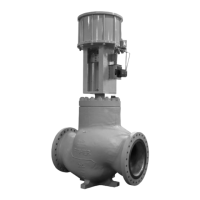
